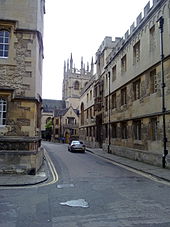- Merton Street
-
 Merton Street, Oxford.
Merton Street, Oxford.
 Merton Street, viewed from the junction with Magpie Lane.
Merton Street, viewed from the junction with Magpie Lane.
 Looking down Merton Street, at the corner with Oriel Square, looking east towards Merton College.
Looking down Merton Street, at the corner with Oriel Square, looking east towards Merton College.
Merton Street is a historic and picturesque cobbled lane in central Oxford, England.[1] It joins the High Street at its northeastern end, between the Ruskin School of Drawing & Fine Art (together with the Examination Schools) and the Eastgate Hotel at the historic east gate of the city. It then runs east-west, parallel and to the south of the High Street for most of its length.
Merton College, one of Oxford's older colleges, is situated to the south of the street. To the west of Merton, Corpus Christi College, one of Oxford's smallest colleges, also fronts onto the street. At the very western end, actually in Oriel Square, is an entrance to Christ Church, Oxford's largest college. At the eastern end can be found the notorious 'Pink House', as well as an entrance to University College.
Logic Lane (through University College, which backs onto the street) and Magpie Lane, both narrow lanes, lead off the street to the north. Also located here is the Merton Street tennis court, a rare example of an extant real tennis court. To the south is Merton Grove (opposite Magpie Lane), providing pedestrian access between Merton College and Corpus Christi College to Christ Church Meadow to the south.
The street is designated the A420 due to the blockage of the High Street to normal traffic. To the west it continues through Oriel Square, where Oriel College is located.[citation needed]
The street occasionally gets repaired incompetently by Oxford City Council using Asphalt, as reported in the Oxford Mail.[2]
History
The part of modern-day Merton Street adjoining the High Street used to be known as Coach & Horses Lane, named after a public house on the west side of the lane.[1] From the early 18th to the late 19th century, it became known as King Street.
The rest of the street (the part running east-west) was originally known as St John Baptist's Street, named after the church which is now Merton College's chapel. In 1751, the whole street had become King Street, but by 1772 just the east-west part was called Merton Street. The entire street became known as Merton Street only in the 20th century.
The academic and author J. R. R. Tolkien had rooms in Merton Street towards the end of his life in the early 1970s.
References
Categories:
Wikimedia Foundation. 2010.
